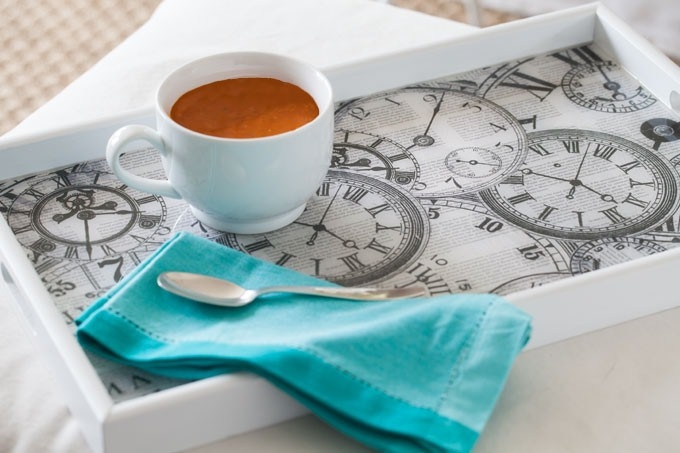I have a before and after thrift store transformation to show you—one that I used a pretty amazing product to complete. Have you ever heard about or used the epoxy resin product EnviroTex Lite? If you have, then you know what an awesome craft product it is.
If you are not familiar with it, EnviroTex Lite is an epoxy resin that you mix and pour onto surfaces that—when dry—looks like glass. It provides a super high-gloss finish over paint, paper or fabric surfaces. I previously used it to transform traditional antique brass drawer pulls into colorful modern ones. Ever since the success of that project, I have been looking for new ways to use the product again.
I found a way. I needed a serving tray to take from my kitchen to family room and found one in the perfect size at the thrift store, but it was not the right color or style that I had in mind. I knew I could change the color with paint to make it fit my personal style- then when I saw scrapbook paper with images of clock faces on it, I knew EnviroTex Lite would make the tray look like it came right from a high-end boutique.

How to Makeover a Wood Tray

Supplies needed:
- 1 kit EnviroTex Lite Pour-On High Gloss Finish
- 2 round, flat sided mixing containers
- Paint stirring stick
- Tray
- 100 grit sandpaper
- DIY chalk paint
- Paint brush
- Scrapbook paper
- Decoupage medium
- Scissors
- Optional: Paste wax and a lint free t-shirt

1. Sand surface of tray to rough it up so the paint has something to grab onto. Clean and let dry.

I chose to cut the scrapbook paper to see how I would fit it into the tray before I painted it, but you can wait to do this step until after you paint the tray.
2. Cut the scrapbook paper design as needed to fit inside the tray. Slightly overlap all the pieces. When you like the way it looks, remove the paper.

3. I made DIY chalk paint using calcium carbonate powder to paint the tray. I needed two coats. I let the first coat dry before I applied the second.

4. Once the paint was dry, I used decoupage medium to attach the cut-out clock images onto the tray. Once the paper was attached, I went over the surface with decoupage medium to seal it. Let dry.

5. Have two round plastic containers with straight sides ready. Empty margarine tubs and plastic coffee containers work well. Mix the hardener with the resin, following instructions that come with the product.

6. Once the two are mixed well, slowly pour it in the tray over the paper. Use a paint stick to gently move the resin into corners.
7. Tiny air bubbles will appear in the surface. You need to remove these, but it is easy. Simply exhale over the surface or blow through a straw. Magically – the air bubbles disappear.

8. Move the tray to a flat surface to dry. After 10 minutes—check to make sure no air bubbles surfaced. If they did, gently blow over them to remove. Let the tray dry for 24 hours.

Once dry, it will be as shiny and smooth as glass. Amazing isn’t it?
Optional: I rubbed a thin layer of paste wax over the painted parts of the tray and buffed it to a subtle sheen.
Here are a few tips before you begin:
- Read the instructions that come in the kit. The most important step is making sure you mix the epoxy the correct way.
- If you are using resin on top of paper, be sure to seal the paper surface first with a few layers of decoupage medium or a similar sealer. Make sure the edges are completely sealed to the surface. If there are any bubbles or cracks, the resin will leak under the paper and cause discoloration.
- When you pour the resin onto your project, tiny bubbles will appear everywhere. The directions say to use a propane torch to easily remove the bubbles. I’ve found that you do not need one. If you see tiny bubbles, gently exhale over the bubbles and they will disappear. I read a tip online to blow slowly through a straw which is what I did and it worked perfectly. (Do not use a blow dryer. It is not the heat that removes the bubbles, it is the carbon dioxide.)
- If you do use the blow-through-a-straw method, be careful that no tiny drips of spit make it onto the resin.
- Make sure to mix enough resin for your project. You don’t want to run out.
- Pour very slowly so that you don’t pour on too much.
- The resin is self-leveling, so just mix it and pour it on!

The possibilities of the surfaces and objects that you can use EnviroTex Lite on are endless – trays, table tops, and cabinet knobs – just about anything. You are only limited by your imagination.












